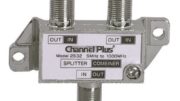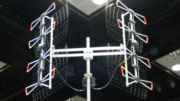Diplexing is defined as two different signals which are combined onto a single wire so they can be split off later. When it works, it’s an effective way to save money and time. It’s far easier to use an existing cable going into the house than putting in a new one.
Diplexing works great when you have two signals that are on different parts of the spectrum. If they don’t share any frequencies at all, and if both are fairly “clean” and free of noise, then diplexing is an effective way to get signals from one place to another.
Diplexing with DIRECTV
Once upon a time, diplexing wasn’t just allowed, it was encouraged. Prior to the early 2000s, most people could not get their local channels with DIRECTV. This meant putting up an antenna and using both the antenna and satellite to watch TV. Until about 2007, most DIRECTV receivers had off-air tuners that allowed you to see off-air channels in the guide and even record them if you had a DVR.
This was done on purpose. Satellite data travels on what’s called the “L Band.” For satellite purposes, this is the 950-2150MHz part of the electromagnetic spectrum. At its most expansive, over-the-air television covered 54-890MHz. This meant that there was absolutely no overlap. In other words, a perfect environment for diplexing.
Nothing lasts forever
Diplexing with DIRECTV officially ended with the introduction of MoCA in 2008. MoCA is a technology that allows network data to sit on the same wire as cable or satellite. It is, in its own way, a form of diplexing. MoCA signals occupy a part of the wire that isn’t being used for video and can provide very smooth video and audio without some of the limitations of Ethernet.
The goal of incorporating MoCA was to allow people to share programming between devices in the home. It’s now the default installation for DIRECTV customers. All the satellite information comes into a Genie DVR. The Genie DVR uses MoCA to distribute programming throughout the home.
DIRECTV’s implementation of MoCA reserves 475-625MHz for its use, with the actual MoCA signal being at 550MHz. This is the same frequency range used for channels 14-39. Using MoCA effectively eliminates the ability to diplex over-the-air signals.
The early workarounds
The thing is, hobbyists really liked diplexing and some adopted a “cold-dead-hands” approach. Some used band stop filters to eliminate all sharing, while others used Ethernet within the home instead of putting the information on the coax cable. Both of these methods were problematic, but people still used them, at least while they could.
There was a period of time where, if there were no broadcasts on 26-30, you could diplex since there was no actual overlap with the DIRECTV MoCA signal. I’ve seen this work in the short term.
Where we stand in 2021
Here in 2021, diplexing over-the-air is dead. There’s no other way of saying it.
The “repack” made things worse
By giving frequencies over to cellular and eliminating channels 38-51, television stations are now grouped in the range from channels 7-36 (with some broadcasters still using 2-6.) This means that practically every broadcast is in the 475-625MHz range. And that means there’s no way to diplex.
The 475-625MHz limit is strictly enforced
You will now get errors if there are signals found anywhere in the 475-625MHz band even if there’s nothing that actually overlaps the MoCA signal. This is part of AT&T’s enhanced testing which is designed to make the experience better for the largest number of people.
Ethernet basically doesn’t work
Running a straight Ethernet installation basically doesn’t work. Existing installs might still work, but again those advanced tests are designed to detect Ethernet installations and not allow them. Ethernet has a lot of error correction built in. This is great when you’re talking about data that you need to be accurate. It’s not great for live television, where you’ll accept a few missed bits in order to keep the stream smooth.
OTA on DIRECTV … isn’t
DIRECTV discontinued ins AM21 antenna module many years ago. This module added over-the-air channels to your DIRECTV guide and let you record them. It’s not only discontinued now, but most people report that their existing AM21s have stopped working as a result of software updates.
The replacement, the Local Channel Connector (LCC) was only made in very small quantities and was not made available for purchase. The only way to get one is if you are in the middle of a channel blackout and there’s no other way to get your locals.
DIRECTV uses an app called Locast which will stream your local channels from the internet instead. It works, but it uses a completely different guide and there is no recording option. In other words, Locast provides live local television just like you would get through an antenna. But if you’re not in one of the 30-ish cities it covers, you can’t use it.
There isn’t likely to be a new DECA
Now that over-the-air television doesn’t use frequencies above 600MHz, DIRECTV could create a new system that uses 600-850MHz instead of 475-625MHz. But, with millions of boxes in the field and a relatively low number of people who want to diplex, they’re not going to do this.
So… is there any good news?
The good news is that you still have some options. You can run that second cable if you want to. You can use Locast. Or, you can stream a lot of the subchannel content that you used to get over the air. So all is not lost. But when it comes to diplexing and DIRECTV, it’s time to put that one to bed.





